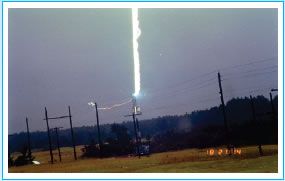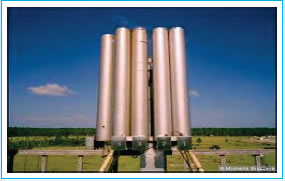|
Cloud to Ground
This is where the lightning travels from the cloud to ground, these strikes usually cause the
most damage the type we often call “forked” lightning. Usually multiple strikes occur along
the same path.
This type of lightning makes up approximately 80% of strikes. |
|
Ground to Cloud
Not very common but may normally be experienced from high objects where the lightning
flash travels from the ground object to the cloud. Damage does result from this discharge.
This type of lightning makes up approximately 10% of strikes |
|
Cloud-to-Cloud
An impressive display of flashes, accompanied by little rain or no thunder.
80% of all lightning is inter- or intra-cloud |
|
Beaded Lightning
Is rather unusual in that beaded lightning persists for some seconds, and then appears to break
up into a string of luminous fragments that gradually fade.
Very rare |
|
Ball Lightning
A very unusual brush discharge reported as a luminous spherical or pear shaped body with a
blurred outline. It normally causes no harm.
Very rare |
| |
|
Bolts from the Blue
One of the most dangerous types of cloud-to-ground lightning are bolts from the blue.
A "Bolt from the Blue" is a cloud-to-ground lightning flash that typically:
- Comes out of the back side of the thunderstorm cloud
- Travels a relatively large distance in clear air away from the storm cloud
- Then angles down and strikes the ground.
These lightning flashes have been documented to travel more than 40 km away
from the thunderstorm cloud. |

|
Intercloud
The least common is the strike between the positive and negative charges within
separate clouds when the strike travels in the air between them. |
|
Intracloud Lightning
Intra-cloud lightning is the most common form of lightning. It appears as a flash within
the cloud occurring between the positive and negative charges that are within the same
thunder cloud. Although this is the most common due to it causing very little danger or
damage not a lot of research has been carried out on it in comparison to cloud
to ground. |
|
Triggered Lightning
Lightning has been triggered directly by human activity in several instances.
Lightning struck the Apollo 12 soon after takeoff, and has struck soon after
thermonuclear explosions. It has also been triggered by launching rockets carrying
spools of wire into thunderstorms. The wire unwinds as the rocket climbs, making a
convenient path for lightning to use. |


|